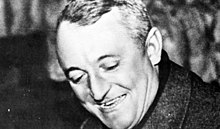
Alfa Romeo Automobiles S.p.A. is an Italian luxury car manufacturer and a subsidiary of Stellantis Italy. It was founded on 24 June 1910 in Milan, Italy, as A.L.F.A., an acronym for Anonima Lombarda Fabbrica Automobili. The brand is known for sport-oriented vehicles and has been involved in car racing since 1911. As of 2023 it is a subsidiary of the multinational automotive manufacturing corporation Stellantis.
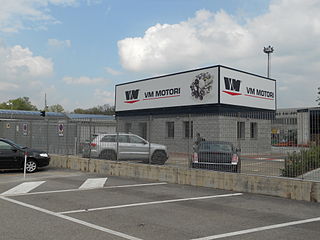
VM Motori S.p.A. is an Italian diesel engine manufacturing company which is wholly owned by Stellantis. VM headquarters and main production facilities are located in Cento, in Emilia-Romagna, Italy.
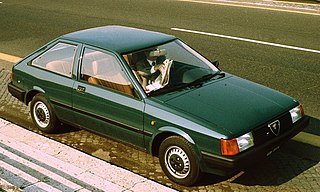
The Alfa Romeo Arna is a hatchback produced by the Italian manufacturer Alfa Romeo Nissan Autoveicoli S.p.A. between 1983 and 1987. The company was founded on 9 October 1980, as a 50:50 joint venture between the Italian Alfa Romeo S.p.A. and the Japanese Nissan Motor Company.

The Alfa Romeo Alfasud is a small family car manufactured and marketed from 1971 to 1989 by Alfa Romeo as a front-engine, four-door, five-passenger entry-level model over a single generation — with facelifts in 1977 and 1980. There was also a two-door sedan, only available in "ti" trim. Alfa Romeo subsequently introduced a three-door wagon variant, the Giardinetta (1975); two-door coupé, the Alfasud Sprint (1976); three-door hatchback (1981) and finally the five-door hatchback (1982).

The Fiat Ducato is a light commercial vehicle jointly developed by FCA Italy and PSA Group, and mainly manufactured by Sevel, a joint venture between the two companies since 1981. It has also been sold as the Citroën C25, Peugeot J5, Alfa Romeo AR6 and Talbot Express and later as the Fiat Ducato, Citroën Jumper, and Peugeot Boxer, from 1994 onwards. It entered the North American market as the Ram ProMaster in May 2014 for the 2015 model year.

Avio S.p.A. is an Italian company operating in the aerospace sector with its head office in Colleferro near Rome, Italy. Founded in 1908, it is present in Italy and abroad with different commercial offices and 10 production sites. Avio operates in:

Rudolf Hruska was an Austrian automobile designer and engineer. He was most famous for his design of various Alfa Romeo cars.
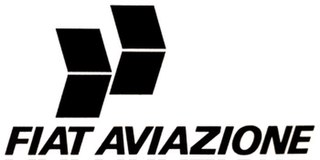
Fiat Aviazione was an Italian aircraft manufacturer, at one time part of the Fiat group, focused mainly on military aviation. After World War I, Fiat consolidated several Italian small aircraft manufacturers, like Pomilio and Ansaldo. Most famous were the Fiat biplane fighter aircraft of the 1930s, the Fiat CR.32 and the Fiat CR.42. Other notable designs were the fighters CR.20, G.50, G.55 and a bomber, the Fiat BR.20. In the 1950s, the company designed the G.91 light ground attack plane.
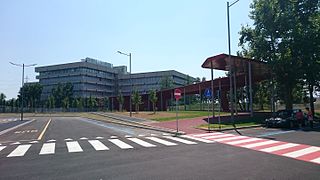
Museo Storico Alfa Romeo is Alfa Romeo's official museum, located in Arese (Milan), and displaying a permanent collection of Alfa Romeo cars and engines.

Fiat Automobiles S.p.A. is an Italian automobile manufacturer, formerly part of Fiat Chrysler Automobiles, and since 2021 a subsidiary of Stellantis through its Italian division Stellantis Italy. Fiat Automobiles was formed in January 2007 when Fiat S.p.A. reorganized its automobile business, and traces its history back to 1899, when the first Fiat automobile, the Fiat 4 HP, was produced.

The Alfa Romeo Arese Plant was a plant area where Alfa Romeo had its head office for more than two decades prior to 1986. After Fiat Group purchased Alfa Romeo in 1986, Arese became one of the assembly plants of Fiat Group. The factory is in the Province of Milan in the Italian region of Lombardy, located about 12 kilometres (7.5 mi) northwest of Milan. The Arese plant replaced the old Alfa Romeo Portello factory and its construction was started in 1960 and took three years and until the end of the 1990s it was the biggest plant of Alfa Romeo covering a very wide area, partly in the territories of Lainate and Garbagnate Milanese. The factory became known as the Arese plant only because the main entrance is in the municipality of Arese.
Sevel S.p.A. is an Italian automotive company which produces light commercial vehicles. It was first established in 1978 by Fiat S.p.A. and PSA Group. Formerly, Alfa Romeo, Lancia and Talbot were also part of the joint venture. Sevel Sud in Italy began manufacturing in 1981. Sevel Nord in France started in 1993. Fiat sold its share of Sevel Nord to PSA in 2012 and re-entered it through the merger of FCA and PSA into Stellantis in 2021. A joint venture extension for Sevel Sud was agreed upon by both automakers in February 2019, preceding the merger of both companies into Stellantis.

Ugo Gobbato was an Italian engineer and Managing Director of Alfa Romeo 1933 to 1945.

Pomigliano d'Arco is a municipality in the Metropolitan City of Naples in Italy, located north of Mount Vesuvius.

The Alfa Romeo Portello Plant in Portello Milan, Italy was the first Alfa Romeo factory, and the main factory between 1908 and the 1960s. The factory was closed in 1986 following FIAT's buyout of Alfa Romeo, but all major production had already been transferred 20 years earlier to the Alfa Romeo Arese Plant. The history of the factory is primarily involved in automobile manufacture, but over the years other products were manufactured as well.

The Alfa Romeo Tipo 103 is a sub-compact front-wheel drive automobile developed by Alfa Romeo in the late 1950s. A prototype powered by a 0.9 L double overhead cam inline-four engine was completed in 1960. Alfa did not put the Tipo 103 into production.
The Alfa Romeo Avio was an Italian aviation company producing aircraft engines active since 1941. It was founded as a division of Alfa Romeo but was sold to Aeritalia in 1986 and then to Fiat in 1996. It was merged with Fiat Avio in 2003 as Avio S.p.A.
Stellantis Heritage is a department established to protect and promote the historic legacy –both automotive and archival– of the Italian brands Alfa Romeo, Fiat, Lancia and Abarth. It was founded in Torino in 2015 to coordinate all the activities which, up to that moment, had been conducted individually by the brands to promote their historical and cultural heritage.
Stellantis N.V. is a multinational automotive manufacturing corporation formed from the merger of the Italian–American conglomerate Fiat Chrysler Automobiles (FCA) and the French PSA Group. The company is headquartered in Amsterdam. As of 2022, Stellantis was the world's fourth-largest automaker by sales, behind Toyota, Volkswagen Group, and Hyundai Motor Group.
The history of Alfa Romeo, an Italian car manufacturer known for producing sports cars, began on June 24, 1910 with the founding of ALFA in Milan. In 1918 the company changed its name to "Alfa Romeo" following the acquisition of control of the company by Nicola Romeo.

